
What pant style is best for your figure? Our philosophy is that any figure type can wear any style as long as it fits properly. Even a person with a large tummy can look nice in a pant with a waistband and the appropriate top. Good fit can make you look 10 pounds thinner! With pants that fit, you will be liberated to wear more variety and to look more fashionable!

Tight pants show off your shape, so unless your shape is perfect, looser pants are universally better for both thinner and heavier bodies. Even a narrow-leg pant will be more flattering if the narrowing is gradual rather than beginning just below the tummy and derriere.
Trousers are a very flattering style since they are loose-fitting and have vertical lines that make you look taller and slimmer. Jeans, on the other hand, are designed to fit tightly, often with no “ease” in the hips. See page 20 for information on ease including the “pinch test.”
More ease isn’t always more flattering, however. A full pant on a petite person can be overwhelming, and a full pant can make a large person look larger.
The good news is that ANY style of pants will be flattering IF THE PANTS FIT. Ease is a personal preference and can be changed to suit the wearer, but it is good to know the amount of ease built into the various styles available so you will know what to expect when you buy a pattern.

Leggings—knit pants that stretch to fit the body. Originally they were used for exercising, but moved into fashion in the 1990s. Unless you have a perfect shape, always wear a long top over them, to cover the derriere.

Traditional jeans—very fitted except in the waist (so you can bend over!). Originally a functional pant for riding horses. Extra crotch ease would cause chafing and saddle sores!

Plain fitted pants—a nice basic, with minimal bulk in the tummy area, especially for wearing with sweaters and tops that are not tucked in.
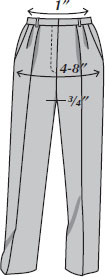
Classic trousers—have slanted pockets, fly front, pleats, and a front crease pressed up to one of the pleats…lots of vertical lines. For the most flattering look, press the deeper pleat and crease flat to the thigh.

Modified trousers—may have slanted trouser pockets and a fly front zipper, but no pleats or crease. Nice if you want a fitted pant with pockets.
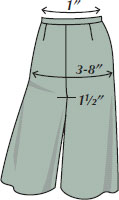
Culottes—pants with a longer crotch. They look like a skirt, so the longer crotch just adds comfort without looking baggy.
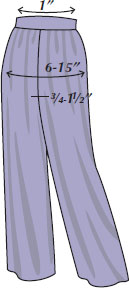
Full evening pants—these must be made of very soft drapey fabrics to be flattering. If you are heavy or petite, buy a smaller size with less ease for the most flattering look.
If you are heavy or short, avoid bulky or stiff fabrics, tweeds, plaids, wide-wale corduroy, and shiny fabrics. They add visual weight. Wool gabardine or wool crepe, microfiber polyester gabardine, and linen-like fabrics are universally flattering pant fabrics. They are heavy enough to drape over and camouflage body bulges, yet not so heavy or textured that they add bulk. Our favorite pant fabric is wool crepe because it is easy to sew, drapes well, and just seems to mold to fit your body.
The most versatile colors are the basics: taupe, beige, black, brown, ecru, gray and navy. You can wear many colors of tops with them. They are also seasonless. If you have a navy wool gabardine pant, you can wear it all year round in most climates. Wool breathes. Pants in colors other than neutrals will be much less versatile, and then each pair will provide limited options in your wardrobe and you will need more pairs of pants to coordinate with your tops.
Your eyes see light, bright, and shiny colors first, so if you want to de-emphasize your hip width, avoid these colors on the bottom. Use them to call attention to your face. Study these drawings to see how color can enhance your figure:

Very light top and dark bottom with strong contrast shorten figure with horizontal line.

Medium light top and medium dark bottom won’t cut the figure in half, yet the eye is still drawn to the face.

Monochromatic (same color) top and bottom is elongating. Colors can be of slightly different shades.
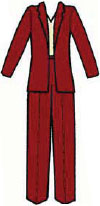
Jacket and pant in same color create a full-length vertical line. Light blouse draws eye to face. This is the most slimming look of all.
Carry swatches of your wardrobe fabrics on a card in your purse to use for color matching while shopping. You will plan better and will look smarter on a much smaller budget.

Also, keep in your wallet the amount of yardage you need for 45″, 54,” and 60″ fabrics for a plain pant and for trousers.
For example, possible yardage needed for size 10:
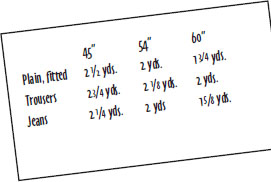
When you buy fabric for pants (see more about fabric, pages 15–17), decide if it would be a good fabric for a jacket, then buy it all at one time since dye lots vary. There are so many different blacks, whites, and navies that you may never match the pants. We go one step further. We buy enough for pants, skirt, and jacket at one time. The cutting advantage gained will often leave enough fabric for a free vest or skirt to be added.
If you are short-waisted or have a full and low bust, a narrow waistband will be more comfortable and flattering.
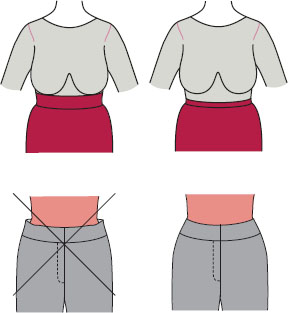
Contour waistbands require tissue-fitting since they must fit well to look good.

Low-riding pants are more flattering if you have a small waistline with a fairly flat tummy.

Pull-on pants fit more smoothly around the waistline if you have little difference between the size of your waist and hip.

If your waist is a lot smaller, you will end up with more gathers. A zipper would be more flattering.
If your pants fit well, jacket length can vary. However, if jackets stop at the fullest part of the hip, they will emphasize hip width. Overall proportion must also be considered—a short person may look better in a shorter jacket. Before making a jacket, pin the pattern pieces together and try on with the finished pants. A full-length mirror will give you your answers.
If the proportion doesn’t seem right, try one of the following:
The wrong shoe can throw off the whole proportion of your outfit. Hosiery is important too. If you want your legs to look their longest, ALWAYS blend your hosiery and shoes with your pant color. Tights or trouser socks can be opaque in the winter, but should be sheer in the summer. A closed-toe pump with a 1½-2″ heel is a universally safe year-round shoe that can be worn with both pants and skirts, so if your budget is tight, this is a great way to go. Avoid wearing out-of-date shoes and stockings. Flip through fashion magazines looking at nothing but shoes and stockings for a quick way to learn current fashion.
Panty lines—Look in the mirror before you go out. Any lines? French cut panties (high side legs) with wide elastic that comes to the waist work well for some figures. It is usually the bikinis that hit you at the middle of your hips that create major dents. Or try panyhose or shapewear with built-in panties, or a thong.
Blouse lines—Pati simply pinks the lower edges of blouses so they are flat when tucked in. Marta serges hers. Also, try tucking blouses into panties or pantyhose. You will be less likely to have panty or blouse lines with looser pants, firmer fabrics, or with lined pants.
When pants go from very fitted to a wide-legged trouser, the shape and length of the crotch changes. Some of your needed alterations may even go away! Here is what happened in the 1970s when the first trousers reappeared since the 1940s. (Pink is a fitted pant and black is a trouser.)
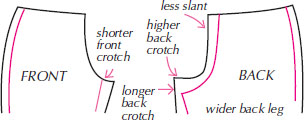
Yes! We can change in weight but not proportions. One of our favorite sayings is “a moment on the lips, a lifetime on the hips.” We can also exercise and tone the figure. One of Pati’s favorite leg exercises is to do side leg lifts while she is brushing her teeth, washing dishes, or fusing interfacings.
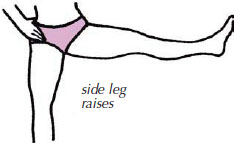
But the easiest way of all to “change” our shape is to create the illusion of svelte by wearing pants that fit!